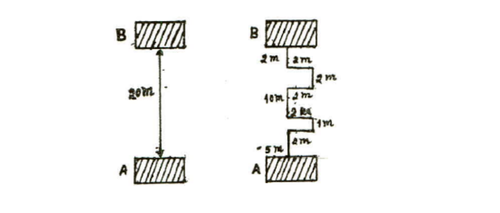Why don't we just go straight?
 A
1
kg
object is lifted from point A to point B through two different pathways as shown in the figure above. What are the respective amounts of work done in the left and right figures?
A
1
kg
object is lifted from point A to point B through two different pathways as shown in the figure above. What are the respective amounts of work done in the left and right figures?
The gravitational acceleration is g = 9 . 8 m/s 2 .
This section requires Javascript.
You are seeing this because something didn't load right. We suggest you, (a) try
refreshing the page, (b) enabling javascript if it is disabled on your browser and,
finally, (c)
loading the
non-javascript version of this page
. We're sorry about the hassle.
6 solutions
Discussions for this problem are now closed
how the distance at figure 2 equal 20
See only verticle distance. Dont count horizontal distance..
Victor you are partially correct.. The questions needs to specify - "work done by whom?"
Gravity and h, both are vectors. so the direction of gravity .. as you assume will be negative (vert. downwards). This results in negative "work done" which is because while gravity acts vertically downwards and the displacement was vertically upward. -> Work done by gravity is -196J. (negative)
On the other hand, there was some force (F) that displaced the body by 2m vertically up. If this force was vertically upward (ie same as the direction of the displacement) .. this results in "positive" work -> Work done by force = 196J (positive)
Should the gravity not be negative?
No...anyway why would gravity be negative that means it will repel everything from it?
"Negative" means that the object is moving against the gravity ,anyway height will be negative too because the same reason, so they will fade each other
Work done is independent of path followed, so in both case the formula is used W=mgh.
It is not zero. It is the same in both cases. There is only one alternative left. Go for it.
Moderator note:
This solution has been marked wrong. Why is it "It is not zero. It is the same in both cases."?
Work done in conservative field is independent of Path...
Moderator note:
You should show that the work done calculated to be 1 9 6 J .
Independently of the "moves" of the block, the important its the High (h), so => W = m.g.h => 1.9,8.20 = 196J
W = m g h = 9 . 8 × 1 × 2 0 = 1 9 6 J , h is equal in both cases thus W is equal 1 9 6 J , 1 9 6 J
Moderator note:
For clarification, you should mention that the work done is independent of its path.
Work done is change in gravitational potential energy and G.P.E. is independent of path W = m g h = 1 × 9 . 8 × 2 0 = 1 9 6 J in both cases